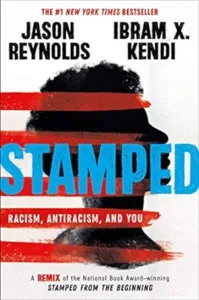Stamped: Racism, Antiracism, and You
Jason Reynolds and Ibram X. Kendi
Little, Brown, Books for Young Readers
Published March 10, 2020
Amazon | Bookshop | Goodreads
About Stamped: Racism, Antiracism, and You
A remix of the National Book Award-winning STAMPED FROM THE BEGINNING for ages 12 and up.
A timely, crucial, and empowering exploration of racism–and antiracism–in America.
This is NOT a history book.
This is a book about the here and now.
A book to help us better understand why we are where we are.
A book about race.
The construct of race has always been used to gain and keep power, to create dynamics that separate and silence. This is a remarkable reimagining of Dr. Ibram X. Kendi’s STAMPED FROM THE BEGINNING, winner of a National Book Award. It reveals the history of racist ideas in America and inspires hope for an antiracist future.
STAMPED takes you on a race journey from then to now, shows you why we feel how we feel, and why the poison of racism lingers. It also proves that while racist ideas have always been easy to fabricate and distribute, they can also be discredited.
Through a gripping, fast-paced, and energizing narrative, Jason Reynolds shines a light on the many insidious forms of racist ideas–and on ways readers can identify and stamp out racist thoughts in their daily lives.
My Review
First, the summary description of the book as “gripping, fast-paced and energizing” is totally accurate. I listened to this book as an audiobook twice in a row. There’s so much information packed into such a short span of pages. It is a lot to take in, so I’m sure this won’t even be the last time I read it. I have a hard copy that I’d like to go back to and highlight certain passages in as well.
So, the summary also says this isn’t a history book. Yet, it talks a LOT about history. It looks at history from the perspective of racism and relationships between black and white people in America. It looks at the beginning ideas about our differences and how those ideas evolved (or didn’t) as history played out.
One of the things I like a lot about the book is that it gives a survey overview of a lot of moments but zooms in on some critical places and familiar people as well. There’s quite a bit of discussion about Thomas Jefferson and the things he believed and where the contradictions are. I found that really helpful to clarify and explain some of the things I already knew about him. It definitely filled in some blanks for me.
I think in school, because we’re looking closely at certain parts of history, I sometimes had a “can’t see the forest for the trees” experience. In this book, Reynolds shows us the forest. We kind of get to see the whole of how the relationship between black and white people developed and changed, the rise of different ideas, and why they were harmful or helpful. I liked that. I don’t think I’ve ever seen dots connected in this way. It actually made me feel like I wish we had more books like this– conversational and easy to understand– about other topics. Give me this, but with the history of the United States from an indigenous perspective. Or from the perspective of women’s rights. LGBTQIA+ rights.
I’m sure some of those books already exist, which is awesome because now I’m hungry for them.
Content Notes
Recommended for Ages 12 up.
Representation
The book references and briefly summarizes the lives of many people, predominantly white men and women and black men and women.
Profanity/Crude Language Content
One instance of mild profanity.
Romance/Sexual Content
References to rape and claims of rape. For example, the book references a movie called Birth of a Nation in which an actor in blackface plays a man who rapes a white woman. No graphic descriptions.
Spiritual Content
Some discussion of the Puritans and early Christian colonists and their views about indigenous people and African people. Some discussion of a church leader and prolific writer who wrote a book that spread fears about witchcraft.
Violent Content
No graphic descriptions of violence, but mentions of enslavement and enslaved people being punished by being whipped. Mentions of people being lynched. Mentions of war.
Drug Content
None.
Note: This post contains affiliate links, which do not cost you anything to use, but which help support this blog.
